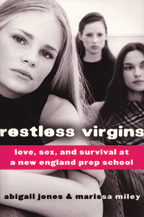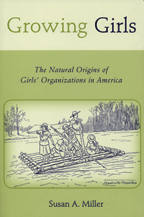Three books about girls (and some boys) survey the perilous landscape of adolescence.
By Maureen Corrigan
“Should I stay or should I go?” That was how The Clash framed ambivalence in 1981, which now seems a veritable Victorian Age of adolescent restraint as compared to the present, when a fire drill now figures as a more extraordinary event in the course of the high-school week than a random session of oral sex. Stay, if you want to try to get a sense of the harsh sexual terrain the teenagers you may know and love are trying to negotiate. Go, if you have the luxury of sidestepping the subject and picking up a Jane Austen novel instead.

THIRD BASE AIN’T WHAT IT USED TO BE: What Your Kids Are Learning About Sex Today—and How to Teach Them to Become Sexually Healthy Adults
Logan Levkoff C’98 GEd’99.
New American Library, 2007. $14.00.
The implicit, no-nonsense “sell” of Logan Levkoff’s guide for parents and teachers, Third Base Ain’t What It Used to Be, is that if adults aren’t willing to give kids the sex information they seek, they’ll probably get it from a self-appointed peer expert, like the “big bully in the backseat” of the school bus who specializes in misinformation and graphic scare stories. Levkoff is a professional sexuality educator. (It seems a predestined career: Levkoff recalls her mother once briskly whipping out a banana and condoms and demonstrating to her two daughters—Levkoff and her sister—how to put on a condom.) Levkoff’s guide is calm, comprehensive, and necessary because, as she acknowledges, the bizarre anatomical misrepresentations of the big bully are no longer a parent’s biggest worry when it comes to their child’s sex education. AIDS, sexual bullying, Internet predators, and a whole host of other contemporary horrors threaten those kids who are not forearmed with knowledge.
Levkoff’s title alludes to the ho-hum view many of today’s teens seem to take toward oral sex: “Oral sex isn’t sex,” Levkoff says students in the middle and high schools she visits tell her. “It’s just third base.” Third base, perhaps, for the guys involved, but a total strikeout for their female partners. As Levkoff details, if the incidence of oral sex is indeed on the rise with teens, their attitudes toward it “are just as screwed up” as in days of old when “good girls” just didn’t do it. Moreover, they’re a dramatic reversal from the heady days (no pun intended) of Second Wave feminism when books like Our Bodies, Ourselves urged women to know and love their vaginas via menstrual luna sponges, speculums, and mirrors. When Levkoff asks a bunch of 40 eighth-grade girls whether they’ve ever been the recipients of oral sex, she says they seemed mortified by the suggestion. Levkoff says: “I believe they answered, ‘Ugh. Down there. That’s so gross!’ Herein lies the problem. We are raising a new generation of women who are set up to be mere performers in their sexual encounters.”
Third Base Ain’t What It Used to Be is similarly smart about issues like the necessity for fathers of adolescent daughters not to stop hugging once they begin sprouting breasts (some girls will seek out physical affection from inappropriate sources); the inevitability, for boys, of unwanted erections and how to handle them; and the corrosiveness of the “friends with benefits” idea, as well as of the all-purpose insult word, slut. In lieu of a house call or school visit from the unflappable Levkoff, her book is a fine resource, especially for parents of budding adolescents, who don’t know how to forge ahead as conversations about sex progress inevitably beyond the “egg meets the sperm” stage into the murkier areas of intimacy, pleasure, and self-esteem.

RESTLESS VIRGINS: Love, Sex, and Survival at a New England Prep School
Abigail Jones EAS’04 and Marissa Miley C’03.
William Morrow, 2007. $24.95.
It’s hard to decide whether Restless Virgins is part of the solution or part of the problem when it comes to teenage sexuality run amok. This nonfiction account of a school year’s worth of guzzling, groping, and grinding at the prestigious Milton Academy prep school outside Boston, loosely reported by fairly recent graduates Abigail Jones and Marissa Miley, belongs to that same genre of pulp anthropological journalism that also sanctions self-important investigations into the romantic lives of Alzheimer’s patients or lifers at women’s prisons. Take the book’s teasing title and its cover: Three pouty-lipped white girls (the most striking a ringer for Peggy Lipton of Mod Squad fame) staring off, bored and lonely, obviously waiting for something or someone to happen to them, to relieve them of their restless virginity. On the book-jacket flap, we hear of “Whitney, the athletic and sensual beauty every girl wants to be; Annie, who craves acceptance but is torn between the desire for peer approval and musical success … and Reed, a ‘hockey god’ who has it all but whose charisma masks a secret insecurity.”
Inside is an account of this preppy Peyton Place culled from 280 interviews with 28 members of the Milton class of 2005. Is the book appealing to our prurient curiosity about hookups and hoedowns among gilded youth? For sure. Is the book grimly enlightening? Yes. Is the book representative of teen life in general? I hope not; but, speaking as the parent of a nine-year-old girl, Restless Virgins makes me think twice about cashing in my 401K in order to afford Milton, or any other tony boarding school, whose assurances of proffering a “first-rate education” have now taken on more salacious overtones.
The (extra)curricular education Milton offers, according to Restless Virgins, focuses on Hamlet-like existential mysteries such as to swallow or not to swallow. So ubiquitous is oral sex that the scandal that serves as the narrative turning point here registers as different in degree only, not in kind, from the anecdotes that make up the rest of the book. (The scandal: On a freezing night in January of 2005, five hockey players met a female student in the team’s locker room; the boys sat down in the wooden stalls where their hockey gear hung and the girl performed oral sex on each of them. By the end of that school year, the story was public and the boys had been expelled; the girl remained enrolled at Milton.) Of much more interest is the way Restless Virginssummons up a detailed panorama of a coarsened teen culture where “guys expected [oral sex] from girls, and many girls accepted the expectation, pleasuring the guy (oftentimes without reciprocation) and hoping for, in return, a potential increase in social status and attention.” In particular, the girls’ stories, in which insecurities about body image and sexual know-how contest with old-fashioned fantasies of romance, ring terribly true.

GROWING GIRLS: The Natural Origins of Girls’ Organizations in America
Susan A. Miller C’83 GEd’83 G’95 Gr’01, faculty. Rutgers University Press, 2007. $23.95.
Growing Girls, by Susan A. Miller, would appear to offer a welcome break from these disturbing images of teen bodies in reckless motion. What could be more soothing, at this point, than a scholarly saga of the social and historical forces that prompted the turn-of-the-20th-century founding of organizations like the Girl Scouts and the Camp Fire Girls—clubs devoted to Good Clean Outdoor Fun? Unfortunately, Miller’s book is so quote-encrusted and otherwise overburdened with source material that, by the close of the final chapter, I felt as though I should have earned a special Girl Scout reading badge. It’s possible to retain scholarly substance while weaving a compelling story—Linda Gordon and Mary Beth Norton have certainly done so, to name but two eminences in women’s history. Miller, a lecturer and undergraduate advisor in Penn’s history department, dulls what potentially could be a terrific tale about emerging cultural views of adolescence in the early 20th century, as well as the warring images of American womanhood promoted by the Girl Scouts vs. the Camp Fire Girls. The archival photos and illustrations here of young ladies in their bloomers and neckerchiefs building fires and trappin’ critters are marvelous (certainly more marvelous than the visions conjured up by either of the previous two books!), but the cultural significance of this female exodus into the forest primeval awaits a more mesmerizing storyteller around the campfire.
Maureen Corrigan Gr’87 is the book critic for National Public Radio’s “Fresh Air,” and critic-in-residence and lecturer at Georgetown University.




